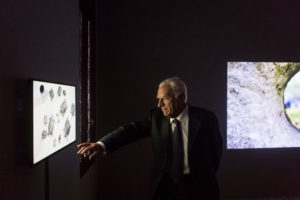CULTURE He Tends Venice’s Jewish History. She Filmed Him.
There are fewer than 500 Jews left in Venice, barely a handful compared with the 5,000 who filled the ghetto here at its height in the 17th century.
Drawn by this diminishing population, the Israeli artist Hadassa Goldvicht made repeated visits, along the way discovering Aldo Izzo, a former ship captain who for 35 years has been guardian and keeper of the two historical Jewish cemeteries on the Lido in Venice.
Mr. Izzo, 86, inspired Ms. Goldvicht, 35, to make her next project about him, recording hundreds of hours of footage with Mr. Izzo and Jewish residents around Venice, studying the meticulous illustrations and entries that fill Mr. Izzo’s daily journals. He keeps track of who has died and who remains.
“I kind of fell in love with him, and I was very occupied with death,” Ms. Goldvicht said in a recent interview. “He is not afraid.”
The result is “The House of Life,” a multiscreen video installation that opened this month at the Palazzo Querini Stampalia Museum in conjunction with the first week of the Venice Biennale. The show, presented by the Israel Museum and Meislin Projects, explores larger themes of a changing city and historical memory through Mr. Izzo’s work caring for and restoring the oldest Jewish cemeteries in Venice, one from 1774, which is still in use, and one from 1386.
“It’s really a piece about the dying community of Venice, an allegory about big issues of life and death,” said Amitai Mendelsohn, senior curator of the Israeli Art department at the Israel Museum in Jerusalem, who organized the show. “Aldo is an intermediary between life and death, a remnant of this Jewish population.”
Since the tombstones — and sometimes even the contents of the graves — had been desecrated, damaged or removed, Mr. Izzo has made restoring both graveyards his life’s work. He has hung the broken headstones that were separated from their grave sites around the cemetery’s enclosed border, creating an installation of its own. In one video, he talks about how some of the headstones have a hole at the bottom, where the soul is said to appear when the dead arise.
“For me, the project is not what’s on the wall, but all these conversations,” Ms. Goldvicht said. “His wife died last year, he’s living alone on the Lido and losing his eyesight, and he’s still going to the cemetery. Aldo is burying the community.”
“It’s kind of like a poem,” she added. “It’s a reduced version of all of it.”
Ms. Goldvicht straddles several subcultures; she comes from a family of Hasidic and rabbinical background and lives in Jerusalem with her husband, Jonatan Benarroch, a kabbalah scholar, with their daughters, ages 2 and 4.
Yet Ms. Goldvicht is also a product of the art world. Her parents, both filmmakers, lived in New York for three years when she was young. She earned a bachelor of fine arts degree in 2004 from the Rhode Island School of Design and a master’s from the School of Visual Arts in New York in 2007. She did an artist residency at the Skowhegan School of Painting and Sculpture in Maine in 2008.
“My upbringing is complex,” she said. “I have a very private relationship with God. I’m not a person who belongs to a community, but I’m fascinated by community.”
“I feel complete where I am,” she added.
A solo exhibition by Ms. Goldvicht, a chapter of “The House of Life,” will open on June 15 at Meislin Projects on the Upper East Side of Manhattan.
The Israel Museum in 2012 presented Ms. Goldvicht’s video installation “Lullaby,” which features people at the museum — from the director to the security guards — singing their childhood lullabies. “‘Lullaby’ is one of the works that’s really worth lingering over,” the Israeli newspaper Haaretz said in its review of the show. “The work took over 50 hours, and deals with memory and vulnerability. Some of the singers waver and seem to be cradling themselves while they sing, momentarily returning to childhood.”
More recently, in Venice, Ms. Goldvicht said, “I don’t draw or paint,” adding, “I kind of feel the materials I work with are life.”
“The House of Life” started in 2013 as an exploration of Jewish residents in Venice. Ms. Goldvicht was an artist in residence then at Beit Venezia, formerly the Venice Center for International Jewish Studies. Her research led her to Mr. Izzo. Last year Venice commemorated 500 years of Jewish life in the city.
“I hope this work is kind of a prayer,” she said. “Discussion about fear, and mix between art and life. It’s mixed. It’s messy.”
At the same time, Mr. Mendelsohn emphasized, “The House of Life” is “not a documentary.” In addition to videos, the show features framed excerpts from Mr. Izzo’s journals and photographs of his cluttered shelves.
“This is an art piece,” he said.
The focus on Mr. Izzo was a way of “narrowing it down to something that is personal and universal,” he added, “historical and mythical.”
*The article was published in The New York Times on May 30, 2017.

